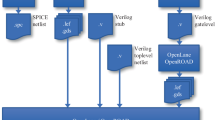Abstract
In this article we address the problem of compacting test response data captured in scan paths. We consider linear compactors, e.g., multiple-input signature registers, and the effect of their characteristic polynomials on the number of aliased faults. The novelty of our analysis lies in that it is based on a realistic error model which takes into account the time correlation among the errors in the test response data fed to the compactor. Such a correlation does exist in scan-based compaction, but has not been considered previously. Based on our analysis, we derive three conditions that should be satisfied to minimize aliasing. They impose little restriction on circuit design.
Similar content being viewed by others
References
M. Abramovici, M.A. Breuer, and A.D. Friedman,Digital Systems Testing and Testable Design, Computer Science Press, New York, 1990.
C. Maunder and R.E. Tulloss,The Test Access Port and Boundary-Scan Architecture. IEEE Computer Society Press, Los Alamitos, CA, 1990.
Y. Zorian, “Automated Built-In Self-Test for Embedded Macrocells,”Proc. ATE and Instrumentation, pp. 57–62, Jan. 1991.
P.H. Bardell, W.H. McAnney, and J. Savir,Built-In Test for VLSI: Pseudorandom Techniques, John Wiley & Sons, Inc., New York, 1987.
J. Rajski and J. Tyszer, “Experimental Analysis of Fault Coverage in Systems with Signature Registers,”Proc. European Test Conf., pp. 45–51, Munich, April 1991.
R. Kameda, S. Pilarski, and A. Ivanov, “Notes on multiple input signature analysis,”IEEE Trans. Comput., vol. 42, pp. 228–234, Feb. 1993.
D. Lambidonis, V.K. Agarwal, A. Ivanov, and D. Xavier, “Computation of Exact Fault Coverage for Compact Testing Schemes,”Proc. IEEE Intl. Symp. Circuits and Systems, pp. 1873–1876, June 1991.
R. David, “Comments on ‘signature analysis for multiple output circuits,”IEEE Trans. Comput., vol. 39, pp. 287–288, Feb. 1990.
J. Savir and W.H. McAnney, “On the Masking Probability with One's Count and Transition Count,”Proc. Intl. Conference on Computer-Aided Design, pp. 111–113, Dec. 1985.
R.C. Aitken, D. Xavier, A. Ivanov, and V.K. Agarwal, “The Role of an Asymmetric Error Model in Predicting Aliasing of Built-In Self-Test for VLSI,”Proc. Canadian Conf. on Electrical and Computer Eng., pp. 356–361, Sept. 1989.
A. Hlawiczka, “Hybrid Design of Parallel Signature Analyzers,”Proc. European Test Conf., pp. 354–360, April 1989.
T.W. Williams and W. Daehn, “Aliasing Errors in Multiple Input Signature Analysis Registers,”Proc. European Test Conf., pp. 338–345, April 1989.
M. Damiani, P. Olivo, M. Favalli, S. Ercolani, and B. Riccó, “Aliasing in Signature Analysis Testing with Multiple-Input Shift Registers,”Proc. European Test Conf., pp. 346–353, April 1989.
D.M. Miller and S. Zhang, “Aliasing in Multiple-Input Data Compactors,”Proc. Canadian Conf. on Electrical and Computer Eng., pp. 347–351, Sept. 1989.
D.K. Pradhan, S.K. Gupta, and M.G. Karpovsky, “Aliasing probability for multiple input signature analyzer,”IEEE Trans. Comput., vol. 39, pp. 586–592, April 1990.
K. Iwasaki and F. Arakawa, “An analysis of the aliasing probability of multiple-input signature registers in the case of a 2m-ary symmetric channel,”IEEE Trans. CAD, vol. 9, pp. 427–438, April 1990.
A. Ivanov and S. Pilarski, “Performance of signature analysis: a survey of bounds, exact and heuristic algorithms,”Integration, the VLSI Journal, vol. 13, pp. 17–38, May 1992.
S. Pilarski and K.J. Wiebe, “Counter based compaction: An analysis for BIST,”Journal of Electronic Testing: Theory and Applications, vol. 3, pp. 33–43, Feb. 1992.
A. Ivanov and Y. Zorian, “Count-based BIST compaction schemes and aliasing probability computation,”IEEE Trans. CAD, vol. 11, pp. 768–777, June 1992.
S. Pilarski, t. Kameda, and A. Ivanov, “Sequential faults and aliasing,”IEEE Trans. on CAD, vol. 12, pp. 1068–1074, July 1993.
S. Pilarski, T. Kameda, and A. Ivanov, “Sequential faults and aliasing,” Tech. Rep. CSS/LCCR TR 92-05, Simon Fraser University, March 1992.
J. Saxena and D.K. Pradhan, “Signature Analysis Under a Delay Fault Model,”Proc. European Design Automation Conf., pp. 285–290, March 1992.
W. Daehn, T.W. Williams, and K.D. Wagner, “Aliasing errors in linear automata as multiple-input signature analyzers,”IBM Journal of Research and Development, vol. 34, pp. 363–380, March/May 1990.
M. Damiani, P. Olivo, and B. Riccó, “Analysis and design of linear finite state machines for signature analysis testing,”IEEE Trans. Comput., vol. 40, pp. 1034–1045, Sept. 1991.
G. Birkhoff and S. MacLane,A Survey of Modern Algebra, Macmillan, New York, 3rd ed., 1965.
W.H. Debany, M.J. Gorniak, D.E. Daskiewich, A.R. Macera, K.A. Kwiat, and H.B. Dussault, “Empirical Bounds on Fault Coverage Loss Due to LFSR Aliasing,”Proc. IEEE VLSI Test Symp., pp. 143–148, April 1992.
F. Brglez, P. Pownall, and R. Hum, “Accelerated ATPG and Fault Grading Via Testability Analysis,”Proc. IEEE Int. Symp. Circuits and Systems, pp. 695–698, June 1985.
Author information
Authors and Affiliations
Additional information
This work was supported in part by grants from the Natural Sciences and Engineering Research Council of Canada and in part by the British Columbia Advanced Systems Institute.
Rights and permissions
About this article
Cite this article
Pilarski, S., Ivanov, A. & Kameda, T. On minimizing aliasing in scan-based compaction. J Electron Test 5, 83–90 (1994). https://doi.org/10.1007/BF00971965
Received:
Revised:
Issue Date:
DOI: https://doi.org/10.1007/BF00971965




